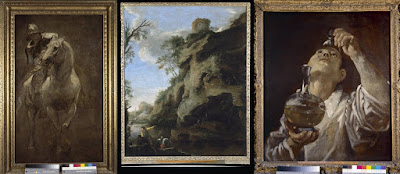 Dirk Obbink,Green Collection.,Hobby Lobby,Oxford,Oxyrhynchus Papyri,papyri,Papyrology,Thames Valley Police
Dirk Obbink,Green Collection.,Hobby Lobby,Oxford,Oxyrhynchus Papyri,papyri,Papyrology,Thames Valley Police
 No comments
No comments
Judgment entered in favor of Plaintiff (Hobby Lobby Stores, Inc). against Defendant (Dirk D. Obbink)
During the period of Obbink's commercial relationship with the MOTB philanthropists he served as the General Editor of the Oxyrhynchus Papyri for the EES (until August 2016). He was also a renowned Lecturer in Papyrology and Greek Literature in the Faculty of Classics at Oxford. That position ended in a fall from grace in February 2021 just as his life as a part time dealer began to unravel.
The seven Hobby Lobby-purchase transactions were itemised as:
Purchase #1 - February 6, 2010: Papyri fragments for $80,000Purchase #2 - February 15, 2011: Papyri fragments and other antiquities for $500,000
Purchase #3 - July 22, 2010: Papyri fragments and other antiquities for $350,000
Purchase #4 - November 20, 2010: Papyri fragments and other antiquities for $2,400,000
Purchase #5 - July 20, 2011: Papyri fragments and other antiquities for $1,345,500
Purchase #6 - March 7, 2012: Papyri fragments and other antiquities for $609,600
Purchase #7 - February 5, 2013: Papyri fragments and other antiquities for $1,810,000
Obbink had represented to Hobby Lobby that the 32 items he was selling all came from private collectors.
In September 2023 Hobby Lobby asked the Magistrate Judge, overseeing the case at the US District Court for the Eastern District of New York to grant their request to transfer their fraud and breach of contract case to the US District Court for the Western District of Oklahoma, where the company is headquartered. On October 5, 2023, their request was granted and on October 17th an amended complaint against Obbink was filed with the court in Oklahoma City which was served on the scholar on 4 November 2023.
Throughout the proceedings, Obbink has failed to appear, plead, or otherwise respond to the unfolding US-based court case, and on January 29, 2024 Hobby Lobby filed a motion seeking a Clerk's Entry of Default. As a result, on March 11, 2024 Senior Judge of the United States District Court for the Western District of Oklahoma, David L. Russell entered a motion for Default Judgment in favour of Hobby Lobby Stores, Inc., awarding them the eye popping sum of $7,085,100.00, with prejudgment interest from February 5, 2013, at the rate of 6% per annum.
Yet despite this scandal of Biblical proportions, Dirk Obbink was last seen on his houseboat, self-destructively ignoring the US and UK legal drama swirling around him.
To recap the last eight years.
In the Spring 2016 the Egyptian Exploration Society realised that the much rumoured "First Century Mark" papyrus that had been the subject of so much speculation was in fact their own papyrus fragment (P.Oxy. 5345).
By August 2016 the EES decided to not re-appoint Obbink as the General Editor of the Oxyrhynchus Papyri primarily because of unsatisfactory discharge of his editorial duties, but also because of concerns, which he did not allay, about his "alleged involvement" in the marketing of ancient texts, especially the controversial Sappho and Gospel of Mark fragments.
By December 2017, according to court documents, Obbink had admitted to Hobby Lobby that he had “mistakenly” sold the Gospel Fragments in Purchase #7 (for $1,810,000) and that they were, in fact, owned by his employer, the Egyptian Exploration Society.
By January 2018 the Museum of the Bible formally severed ties with the Oxford-based scholar.
On 16 April 2019 Obbink's UK-based antiquities sale's enterprise, Castle Folio Limited was dissolved.
By June 2019 the Egyptian Exploration Society took a harder stance against their former colleague and banned Obbink from any access to its collection pending his satisfactory clarification of the 2013 contract.
On 2 March 2020 Obbink was "detained" briefly by officers from Thames Valley police on suspicion of theft and fraud. Unnamed at the time by the British authorities, he was released after questioning.
By February 2021 Obbink no longer held his position as Lecturer in Papyrology and Greek Literature in the Faculty of Classics at Oxford University and had retreated to his houseboat where he was served in relation to the US court case.
Yet, to date, and despite the ongoing investigation by the Thames Valley Police, Dirk Obbink has inexplicably still not been charged with any crime in the United Kingdom.
By: Lynda Albertson









